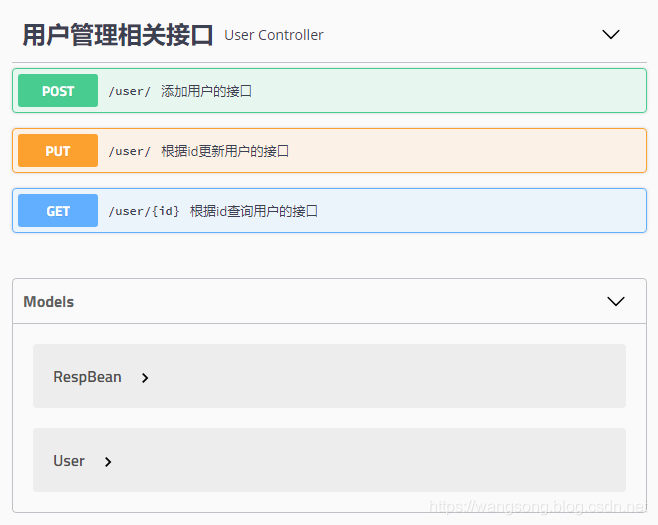一、导入maven包
<dependency> <groupId>io.springfox</groupId> <artifactId>springfox-swagger2</artifactId> <version>2.9.2</version> </dependency> <dependency> <groupId>io.springfox</groupId> <artifactId>springfox-swagger-ui</artifactId> <version>2.9.2</version> </dependency>
二、添加工具类
@Configuration @EnableSwagger2 public class SwaggerConfig { @Bean public Docket createRestApi() { return new Docket(DocumentationType.SWAGGER_2) .pathMapping("/") .select() .apis(RequestHandlerSelectors.basePackage("com.nvn.controller")) .paths(PathSelectors.any()) .build().apiInfo(new ApiInfoBuilder() .title("SpringBoot整合Swagger") .description("SpringBoot整合Swagger,详细信息......") .version("1.0") .build()); } }
三、添加注解
@RestController @Api(tags = "用户管理相关接口") @RequestMapping("/user") public class UserController { @PostMapping("/") @ApiOperation("添加用户的接口") @ApiImplicitParams({ @ApiImplicitParam(name = "username", value = "用户名", defaultValue = "李四"), @ApiImplicitParam(name = "address", value = "用户地址", defaultValue = "深圳", required = true) } ) public RespBean addUser(String username, @RequestParam(required = true) String address) { return new RespBean(); } @GetMapping("/") @ApiOperation("根据id查询用户的接口") @ApiImplicitParam(name = "id", value = "用户id", defaultValue = "99", required = true) public User getUserById(@PathVariable Integer id) { User user = new User(); user.setId(id); return user; } @PutMapping("/{id}") @ApiOperation("根据id更新用户的接口") public User updateUserById(@RequestBody User user) { return user; } }
四、注解说明
- @Api注解可以用来标记当前Controller的功能。
- @ApiOperation注解用来标记一个方法的作用。
- @ApiImplicitParam注解用来描述一个参数,可以配置参数的中文含义,也可以给参数设置默认值,这样在接口测试的时候可以避免手动输入。
- 如果有多个参数,则需要使用多个@ApiImplicitParam注解来描述,多个@ApiImplicitParam注解需要放在一个@ApiImplicitParams注解中。
- @ApiImplicitParam注解中虽然可以指定参数是必填的,但是却不能代替@RequestParam(required = true),前者的必填只是在Swagger2框架内必填,抛弃了Swagger2,这个限制就没用了,所以假如开发者需要指定一个参数必填,@RequestParam(required = true)注解还是不能省略。
五、如果参数是一个对象,对于参数的描述可以放在实体类中。
@ApiModel public class User { @ApiModelProperty(value = "用户id") private Integer id; @ApiModelProperty(value = "用户名") private String username; @ApiModelProperty(value = "用户地址") private String address; //getter/setter }
六、效果

附:如果我们的Spring Boot项目中集成了Spring Security,那么如果不做额外配置,Swagger2文档可能会被拦截,此时只需要在Spring Security的配置类中重写configure方法,添加如下过滤即可:
@Override public void configure(WebSecurity web) throws Exception { web.ignoring() .antMatchers("/swagger-ui.html") .antMatchers("/v2/**") .antMatchers("/swagger-resources/**"); }